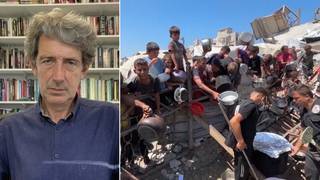
Guests
- Arnie Gundersenformer nuclear industry senior vice president who has coordinated projects at 70 nuclear power plants around the country. He provides independent testimony on nuclear and radiation issues to the NRC, congressional and state legislatures, and government agencies and officials in the U.S. and abroad. He is the chief engineer at Fairewinds Associates and co-author of the Greenpeace report, “Lessons from Fukushima.”
The Nuclear Regulatory Commission has acknowledged the massive Sandy storm could impact both coastal and inland nuclear power plants. At least 16 reactors are in the storm’s projected path, including North Anna and Surry in Virginia; Calvert Cliffs in Maryland; Oyster Creek, Hope Creek and Salem in New Jersey; Indian Point in New York; Millstone in Connecticut; and Vermont Yankee. So far, there have been no reports of reactors shutting down, despite operating under licenses that require them to do so if weather conditions are too severe. “The biggest problem, as I see it right now, is the Oyster Creek plant, which is on Barnegat Bay in New Jersey,” says former nuclear executive Arnie Gundersen, noting it lies in the projected eye of the storm. “Oyster Creek is the same design, but even older than Fukushima Daiichi unit 1. It’s in a refueling outage. That means that all the nuclear fuel is not in the nuclear reactor, but it’s over in the spent fuel pool. And in that condition, there’s no backup power for the spent fuel pools. So, if Oyster Creek were to lose its offsite power — and, frankly, that’s really likely — there would be no way cool that nuclear fuel that’s in the fuel pool until they get the power reestablished. … The most important lesson we can take out of the Fukushima Daiichi and climate change, and especially with Hurricane Sandy, is that we can’t expect to cool these fueling pools.” [includes rush transcript]
Transcript
AMY GOODMAN: We continue our coverage of Hurricane Sandy. The Nuclear Regulatory Commission has acknowledged the massive storm could impact coastal and inland nuclear plants. At least 16 plants are in the storm’s projected path, including North Anna and Surry in Virginia; Calvert Cliffs in Maryland; Hope Creek and Salem in New Jersey; Indian Point in New York; Millstone in Connecticut. So far, there have been no reports of reactors shutting down, despite operating under licenses that require them to do so if weather conditions are too severe.
The Nuclear Regulatory Commission met on Sunday to discuss the precautions needed to secure vulnerable plants during the storm. Spokeswoman Diane Screnci said, quote, “They’re all designed to withstand the natural phenomena, including hurricanes and what comes with hurricanes—high winds, high water, that kind of thing.”
Well, for more, we go now to Burlington, Vermont, to speak with Arnie Gundersen, former nuclear industry senior vice president who has coordinated projects at 70 nuclear power plants around the country, now chief engineer at Fairewinds Associates.
Arnie Gundersen, welcome to Democracy Now! Talk about what you’re concerned about.
ARNIE GUNDERSEN: Yeah, thanks for having me. The key here is that when a uranium atom splits, that only gives off about 95 percent of the power, so when these plants shut down, 5 percent of the power is still going to come out of the power plants after they’re shut down. I think the industry should preemptively shut down plants in the storm’s wake, but it’s not going to solve the entire problem. It’s really likely that the grid, the electric grid that’s out there, will collapse, and these plants will become islands, electric islands, and they’ll have to rely on their diesel generators to provide power. A bunch of these plants are in refuelings right now. And when you’re in a refueling outage, you are not required to have all your diesels running. You can be tearing apart one and only have one diesel available. So the concern is that, should they lose offsite power, all of this heat needs to be removed, and you’re relying on just one diesel to keep the nuclear reactor cool.
AMY GOODMAN: Can you talk about what you feel needs to happen right now? And talk about nuclear power plants in Connecticut, in Vermont, your main concern.
ARNIE GUNDERSEN: Yeah. The biggest problem, as I see it right now, is the Oyster Creek plant, which is on Barnegat Bay in New Jersey. That appears to be right about the center of the storm. Oyster Creek is the same design, but even older than Fukushima Daiichi unit 1. It’s in a refueling outage. That means that all the nuclear fuel is not in the nuclear reactor, but it’s over in the spent fuel pool. And in that condition, there’s no backup power for the spent fuel pools. So, if Oyster Creek were to lose its offsite power—and, frankly, that’s really likely—there would be no way cool that nuclear fuel that’s in the fuel pool until they get the power reestablished. Nuclear fuel pools don’t have to be cooled by diesels per the old Nuclear Regulatory Commission regulations. I hope the Nuclear Regulatory Commission changes that and forces the industry to cool its nuclear fuel pools, as well.
This time of year, there’s a lot of power plants in refueling outages. And all of those plants will be in a situation where there’s no fuel in the nuclear reactor; it’s all in the fuel pool. Systems have been shut down to be maintained, including diesels, perhaps even completely dismantled. And in the event that there’s a loss of offsite power from the high winds from this hurricane, we will see the water in the fuel pools begin to heat up.
AMY GOODMAN: Neil Sheehan, a representative of the U.S. Nuclear Regulatory Commission, said, “These plants have to be able to withstand all sorts of natural phenomena: earthquakes, severe flooding, tropical storms, lightning storms, tornadoes. They need to be able to deal with all of that. We like to say they’re very robust structures, they can deal with a lot of punishment, but at the same time they have procedures in place to guide them through this.” So then, Arnie Gundersen, what is your concern?
ARNIE GUNDERSEN: You know, this isn’t like—like the Big Bad Wolf. They can huff and puff, and they won’t blow this plant down, especially a hurricane that’s only 85-mile-an-hour winds. It’s not a question of the winds from this hurricane blowing the plant down. It’s a question of the loss of offsite power. That’s exactly what happened after Fukushima Daiichi. The earthquake destroyed the offsite power. At that point, the nuclear plant relies on its diesels. And my big concern is diesel reliability and the fact that nuclear plants don’t have to cool their nuclear fuel pools off their diesels per NRC regulations. I think those are the two big concerns for Hurricane Sandy.
AMY GOODMAN: Tell us what’s happening in Vermont. Tell us what’s happening with Vermont Yankee, Arnie Gundersen, a plant you know well.
ARNIE GUNDERSEN: Yeah. Irene hit Vermont Yankee pretty hard. And we are expecting a little less rain from Sandy than we were from Irene. What was interesting—talk about the law of unanticipated consequences—there was so much flooding in Vermont that large gas canisters that people had in their backyard to heat their homes or heat their trailer parks or to heat their barbecues went floating down the Connecticut River and bumped into a hydroelectric dam, which is just south of Vermont Yankee. And the state police actually blocked off the road heading into Vermont Yankee because they were afraid all the hydrogen in those canisters was likely to explode. Now, that’s not in the design bases of a nuclear plant. Nobody ever thought that we’d have to worry about explosive gases floating down rivers by our nuclear plants and potentially causing damage. Here in Vermont, I think we’ll have a less severe event near our nuclear plant than we had last year, but it really depends on the degree of the flooding.
AMY GOODMAN: What are the most important issues we can learn from Fukushima right now in the United States? And how does climate change fit in with both, Arnie Gundersen?
ARNIE GUNDERSEN: Well, climate change has affected nuclear plants this year. Quite a few had to reduce power in the summer because river flow rates had dropped and there wasn’t enough water to cool them. And that happened in France and around the world, as well. So we portray nuclear power as a way to eliminate climate change, but in fact we need to solve climate change before we can have nuclear power plants, because there’s just not enough cooling water to cool these plants in the event of hot summers.
Well now, in the fall, and the lesson from Daiichi, is that the nuclear fuel pools are a major liability. There’s more nuclear—more cesium in the fuel pool at Vermont Yankee than was ever exploded in all of the 700 above-ground bomb testing. I think the most important lesson we can take out of the Fukushima Daiichi and climate change, and especially with Hurricane Sandy, is that we can’t expect to cool these fueling pools. We need to remove the fuel. We need to put it in dry casks and get it down from these high fuel pools, get it down onto the ground in dry cask storage. The Nuclear Regulatory Commission is not insisting on that, because it’s going to cost a couple billion dollars for the industry.
AMY GOODMAN: Arnie Gundersen, I want to turn south for a moment to Patrick Elie.












Media Options